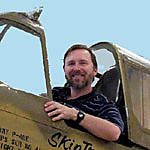Fascinating. Nothing really new except corroboration with anecdotes that the Bf 109E could ' out turn' the Spitfire because the 109's stalling characteristics gave the pilots more confidence to reef one around tight, whereas the Spitfire pilots were hesitant to fly to the edge of the envelope. This is interesting to me due to the reported gentle stall characteristics of the Spitfire.
Another item of interest is just how well the P-36 rolled -- twice as fast as the Spit and 109.
http://kurfurst.org/Tactical_trials/109E_UKtrials/Morgan.html
Hosted by Rowan Baylis
Me. 109 Manoeuvrability Tests, 1940
Posted: Thursday, January 13, 2011 - 01:56 AM UTC
GastonMarty

Joined: April 19, 2008
KitMaker: 595 posts
AeroScale: 507 posts

Posted: Tuesday, February 01, 2011 - 08:36 PM UTC
Yes it is a very interesting report, but there are a number of falsehoods and assumptions that are very much in evidence here:
Quote: "The turning performance of the Hurricane is probably little different from that of the Spitfire, these aircraft being roughly similar in wing loading and level performance."
This was not true at all according to Hurricane pilot John Weir: The Hurricane was superior in sustained turns to the Spitfire and the Me-109s. Only when the FW-190A appeared on the scene did the Hurricane start to lose out in sustained turns...: "Those just kept coming"
Despite this, the Spitfire did have a tighter initial turning radius than the Me-109 or the FW-190A, but this did not carry over to sustained turns vs the FW-190A... (In the exact same way, the Me-109G was utterly hopeless against the P-47D in sustained turns, especially to left, despite a likely tighter initial radius in unsustained turns)
Quote: "During the dog-fights against the Hurricane and Spitfire, it became apparent that our fighters could out-turn the Me.109 with ease when flown by determined pilots. Since the minimum radius of turn without height loss depends largely on stalling speed, and hence on wing loading, the poor turning performance of the Me.109 may be ascribed to its high wing loading, 32.2 lb./sq. ft. compared with 24.8 lb./sq. ft. on the Spitfire."
This assumption about wingloading is mostly correct for maximum rate unsustained turns at around 5-6 Gs (usually at 300 MPH + minimum): It has nothing to do with sustained turn performance around 3 Gs below 200 MPH, hence the false assumption of Spitfire sustained turn performance superiority when in fact that belonged mainly to the Hurricane... But again, the Spitfire did display the tighter initial radius vs the Me-109 or the FW-190A, leading to many quick victories over both.
I have been told by aero engineers that sustained 3 Gs turns and unsustained 6 G turns are equivalent, in that the aircraft best at one will do best at the other because of the wingloading: For prop fighter aircrafts, almost all WWII combat pilot accounts show this to be false: Aero engineer are not capable of predicting the actual superiority in sustained turns of aircrafts like the P-47D or the FW-190A over others like the Me-109G or even the Spitfire... Many test pilots (and thus official tests) of the time show agreement with the wingloading prejudice because they extrapolate unsustained turn performance into sustained turns...
Not all did (those test pilots of KG 200 for instance, who noted: "The P-47D out-turns our BF-109G", in agreement with actual combat, all the way down to on-the-deck at 140 MPH...), and neither did most combat pilots either, which is why the issue appears so muddied: Combat pilot actual memories of actual fighting are just "anecdotal", while totally contradicting tests conclusions have retained the ever-lasting permanence of official documents. So it goes...
Gaston
 |











